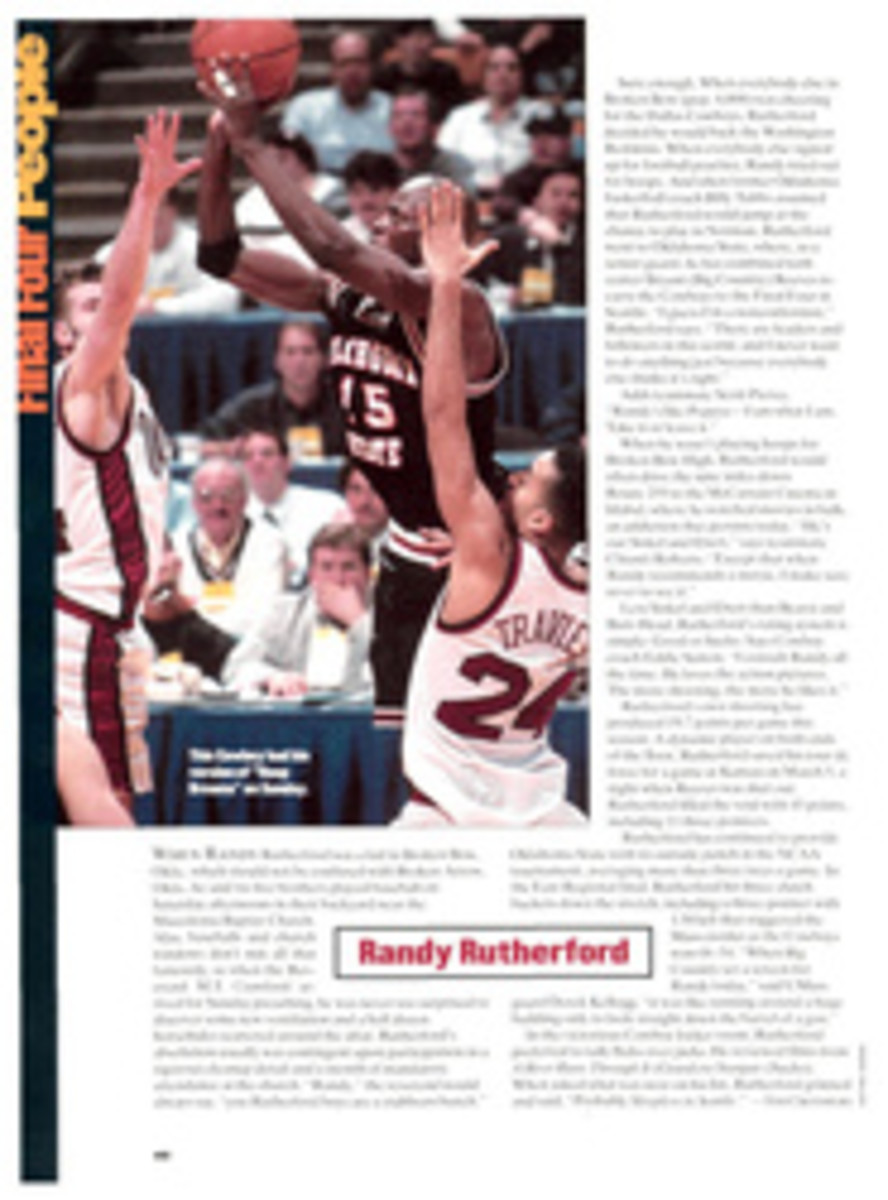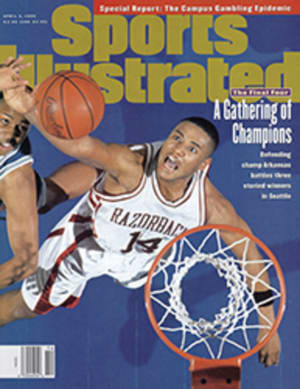
TOUGH GUYS WEAR PINK IN ANY COLOR, JUDO MASTER AND FILM STUNTMAN GENE LEBELL IS ONE HARD HOMBRE
It's hard to believe. The toughest man alive is standing before
me wearing pink pajamas. O.K., they're not really pajamas but
rather a baggy judo uniform that has been dyed bright pink. Still,
the person martial arts media such as Inside Kung-Fu magazine have
since the 1950s dubbed ``the toughest man alive'' turns out to be
62 years old, and he is wearing not only rose-colored clothing
but also a pair of reading glasses, which together make him look
like a benevolent grandfather on Christmas morning. I'm
beginning to think I'm in the wrong gym until the old man says,
``Let me show you something fun'' and slaps an Indian death lock
on me.
``This is also a good one,'' he says, rolling me over into a
hold he calls the figure-four double ouch. ``Then you can try
this. . . .''
The pudgy hands of Gene LeBell, nicknamed Judo Gene by a TV
announcer in the 1950s, work me over with an excruciating series
of locks, cranks and stretches -- each punctuated by LeBell's
question, ``Now who's better looking, you or me?''
It is a provocative notion, given that LeBell's face bears the
marks of 55 years of judo, wrestling, boxing, karate and movie
stunt work. There is scar tissue around his eyes. His nose has
been bashed bulbous, and his ears have gone beyond cauliflowered
to broccolied. One does not easily come by a reputation as the
toughest man alive.
LeBell, though, was literally born into the esoteric brotherhood
of professional tough men. His mother, Aileen Eaton, began
promoting boxing and wrestling at Los Angeles's Olympic Auditorium
in 1942. At the time she was the only female promoter in the
country. This tiny, widowed mother of two was a shrewd
businesswoman who made the Olympic a popular boxing arena. She
also revolutionized professional wrestling by persuading a
grappler named George Wagner to dye his hair blond and hire a
valet. Thus was born Gorgeous George.
Lacking a father figure, Gene LeBell was enthralled by the
larger-than-life figures who worked for his mother. He got his
first wrestling lesson at seven when he asked former professional
heavyweight champion Ed (Strangler) Lewis for instruction. The
300-pound Lewis obviously had a soft spot for children. ``He
slapped a headlock on me, and I felt like the room was spinning
for 10 minutes,'' says LeBell.
At 12 LeBell took up judo. To round out his education in the
martial arts, he also began frequenting the Main Street Gym in
Los Angeles, where the West Coast's best boxers gathered. One
day in 1948, when he was 16, LeBell found himself in the gym
with Sugar Ray Robinson. Robinson asked the teenager if he felt
like sparring. Ever humble, LeBell agreed and promised not to
hurt the welterweight champion. After being hit by about 300 of
Robinson's jabs, LeBell told his sparring partner to come back
the next day if he wanted another beating.
LeBell's manic, varied training paid off when he won the 1954 AAU
National Judo Championships. As an unknown 21-year-old, he pinned
John Osako, considered the top judo player in the U.S., in his
first match of the tournament. Although LeBell weighed only 160
pounds, he won the heavyweight division and the overall title. The
following year he repeated as national champion, winning 18
matches in two days. So superior was LeBell that he won 17 of
those matches with standing throws, never being forced to grapple
on the mat.
``At the time, it wasn't that hard, because I was training with
300-pound wrestlers,'' LeBell says. ``The wrestlers back then were
tougher.''
After LeBell won his second championship, he traveled to Japan
with a group from the Air Force to train and compete with the
world's best judo players as well as karate and aikido masters. He
often practiced in Tokyo at the Kodokan, the headquarters of judo,
where he would work the ``slaughter lines,'' fighting a series of
opponents until he lost. LeBell typically ran through lines of 20
men.
It was also in Japan that LeBell's uniform was accidentally
laundered with other, brightly colored clothing and emerged from
the washer a deep pink. He wasn't unhappy. ``It was something
different,'' he says, ``and when people teased me about it, it was
a good excuse to get them on the mat and stretch their bodies a
bit.''
Because judo was strictly amateur, LeBell turned to professional
wrestling to make money. His first match, in 1955, was at the
Olympic Auditorium. The two-time U.S. judo champion was cheered by
the crowd for the first -- and last -- time. Knowing that the
highest-paid performers were the bad guys, LeBell sought to become
the nastiest wrestler of all. He was so unpopular that in order
not to embarrass his family he often wore a mask, fighting under
the name of the Hangman.
In 1960 LeBell held the world wrestling championship -- for all of
12 seconds. After defeating champion Pat O'Connor in what he
insists was a legitimate wrestling match, LeBell accidentally hit
the commissioner in the face with the championship belt while
posing for photographers. Thinking he had been hit intentionally,
the commissioner disqualified LeBell and stripped him of his
title.
It would be easy to blame any of LeBell's antisocial tendencies on
the fact that he had no father, but in truth, Judo Gene was
raucous almost from the beginning. When he was five, his older
brother, Mike, contracted diphtheria and was confined for six
months to a wheelchair. One day Gene took Mike for a stroll and
left him in the middle of busy Olympic Boulevard. Mike survived
and got even. As a wrestling promoter he fired Gene more than
once. ``What Gene did was terrific,'' says Mike, now 64, ``but
sometimes even I thought he was crazy.''
Gene first worked as a movie stuntman in 1955, and his movie work
gradually replaced wrestling. Stunt coordinators hired him
because he could take a punch better than anyone, and they knew
actors would be safe with him. The toughest man alive has been
beaten up by everyone from Jerry Lewis (``I was ahead on points,''
LeBell says) to Ruth Buzzi (``She blindsided me''). He has
appeared in so many movies and TV shows that he has made more than
$100,000 annually in residuals the last 25 years. ``People in the
stunt world can't say enough nice things about Gene,'' says Roydon
Clark, a stunt coordinator. And actors know he will always lose.
When the cameras aren't rolling, however, it's a different story.
Except for one defeat as a teenager, LeBell was unbeaten in his
judo career, winning more than 2,000 matches in eight years. In
training he has bested half a dozen Olympic gold medalists. Even
years after retiring from competition he was virtually
untouchable. LeBell's son, David, himself an accomplished judo
player, recalls two-time Olympic gold medalist Willem Ruska
visiting from the Netherlands to learn some grappling moves,
which, by the way, could never be used in judo competition. ``My
father showed him a few new ways to tie a man's limbs in knots,''
says David.
Bob Wall, a former world professional karate champion and a friend
of LeBell's, used to bring martial arts stars Chuck Norris and
Bruce Lee to train in karate and judo with LeBell. Wall and Norris
were co-owners of a karate school, and Norris and Lee helped
LeBell find work in movies. ``The first time Lee sparred with
Gene, Gene picked him up and held him overhead,'' says Wall.
``Bruce said, `When you put me down, I'm going to get you,' so
Gene just kept him up there a while. Gene is absolutely the
toughest man alive.''
LeBell, though, prefers to play down the sobriquet. ``People
saying you're the toughest guy around is great, but it still
doesn't add up to one car payment. Now I get beat up by every wimp
in Hollywood and make thousands of dollars. You tell me which is
better.''
At his age LeBell thinks of himself as a teacher rather than a
fighter. He works with martial artists selected to develop new
methods of hand-to-hand combat for the L.A. police department and
still teaches a judo class in his cabin about 75 miles north of
Los Angeles. He has trained six national judo champions, including
the current U.S. titleholder, a former Soviet named Gokor
Chivichyan. ``There were a lot of beautiful judo players in the
Soviet Union, but no one like Gene,'' says Chivichyan, 31. ``I
hope I have half his strength when I'm his age.''
As if to prove the point, LeBell gladly shows off his abilities
whenever a visitor is foolish enough to ask for a demonstration.
And LeBell can't stand to let someone leave without applying a
last wrenching hold accompanied by the question, ``Now who's the
best-looking guy around?''
You are, Judo Gene. Absolutely.
Mark Jacobs, of White Plains, N.Y., writes often for Sports
Illustrated
COLOR PHOTO:JOHN LIVZEYThe hammerlock business has been good to LeBell, but not always to students such as Chivichyan. [Gene LeBell holding Gokor Chivichyan in a hammerlock]
B/W PHOTO:COURTESY OF GENE LEBELLLeBell was a natural to ref Muhammad Ali's bout with Japanese wrestler Antonio Inoki in '76. [Gene LeBell and Muhammad Ali in ring]B/W PHOTO:(C)AMERICAN INTERNATIONAL PICTURES One of LeBell's many celluloid losses was to Jim Brown in Slaughter's Big Rip-off. [Gene LeBell on Jim Brown's back in scene from movie]

